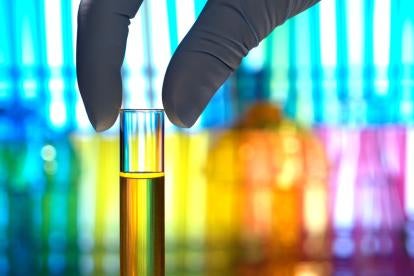The chemical 1,4-dioxane has become a hot topic for EPA and state regulators. New York recently adopted a law banning more than trace amounts of the chemical in cosmetics, personal care products, and cleaning products. California is considering 1,4-dioxane in personal care and cleaning products under its Safer Consumer Products regulation. Meanwhile, EPA is proceeding with a years-long examination of 1,4-dioxane, but its review does not consider 1,4-dioxane as a contaminant – and the chemical exists only as a contaminant in consumer products. These activities may have implications for future regulation of PFAS in consumer products as well.
What is 1,4-dioxane?
According to the Agency for Toxic Substances and Disease Registry (ATSDR), 1,4-dioxane, CAS No. 123-91-1, is used primarily as a solvent in the manufacture of chemicals and as a laboratory reagent, and it has a variety of adverse health effects.
Due to its uses, workers may have the highest levels of exposure to 1,4-dioxane. EPA’s June 2019 draft risk evaluation did not identify any expected consumer uses of 1,4-dioxane. ATSDR has noted, however, that the chemical is a trace contaminant of some chemicals used in cosmetics, detergents, and shampoos. The general population may have exposure to 1,4-dioxane from drinking water, the result of industrial discharges and disposal of consumer products down the drain.
New York Sets Maximum 1,4-Dioxane Levels in Consumer Products
Citing drinking water concerns, Governor Cuomo signed into law New York Senate Bill No. 4389B/A 6295A to regulate 1,4-dioxane on December 9, 2019. The legislature had passed the bill six months earlier. The law amends or adds sections 35-0105, 37-0115, and 71-3703 of New York’s Environmental Conservation Law, effective January 1, 2022. For the first time, there will be limits on the permissible amount of the chemical in three types of products: household cleaning, cosmetics, and personal care. It imposes the following limits, in parts per million, and manufacturer deadlines on 1,4-dioxane:
-
Household cleaning products:
-
2 ppm, by December 31, 2022
-
1 ppm, by December 31, 2023
-
-
Cosmetic products:
-
10 ppm, by December 31, 2022
-
-
Personal care products:
-
2 ppm, by December 31, 2022
-
1 ppm, by December 31, 2023
-
Since these levels were set by legislative action, there is no official justification for them that reviews the science, explains how they were selected, and examines their feasibility. Industry had unsuccessfully advocated for a 10 ppm level for all three categories, objecting that the levels ultimately set will entail compliance costs in the billions of dollars. Individual manufacturers may apply for a one-year extension on the basis of feasibility.
Starting in 2025, the New York Department of Environmental Conservation must evaluate these levels every two years and consider whether to lower them. The DEC may adopt implementing regulations. Penalties may be assessed up to $1,000 per day of violation, or $2,500 per day for a second violation.
Once compliance with those levels is mandatory, a manufacturer of affected products must either exit the New York market or comply. Typically, it is impractical to have two versions of a product, one that meets a single state’s requirements and a second that does not. Accordingly, these limits may effectively become nationwide limits that manufacturers must meet in order to sell their cleaning products, cosmetics, and personal care products anywhere in the country.
California Considers Regulating 1,4-Dioxane in Consumer Products
California has already adopted warning or disclosure requirements for 1,4-dioxane in products. The Office of Environmental Health Hazard Assessment (OEHHA) has listed 1,4-dioxane as a carcinogen under Proposition 65 since 1988. OEHHA has assigned it a safe harbor level for exposure of 30 µg/day. The California Safe Cosmetics Act of 2005 directs manufacturers of cosmetics sold in the state to provide the Division of Environmental and Occupational Disease Control in the Department of Health Services with a list of their cosmetic products that contain a chemical identified as a carcinogen under Proposition 65. The Cleaning Product Right to Know Act of 2017 mandates a website posting of a list of nonfunctional constituents of cleaning products. For 1,4-dioxane, the threshold is 10 ppm. That posting requirement applies to cleaning products sold in California on or after January 1, 2020.
In 2019, California began a process that may result in regulatory limits on 1,4-dioxane in personal care and cleaning products. The Department of Toxic Substances Control identified 1,4-dioxane as a Candidate Chemical under its Safer Consumer Products Regulations in 2013. In 2019, it launched an initiative that may lead to increased pressure on manufacturers to reduce 1,4-dioxane levels in their consumer products.
On May 23, 2019, DTSC issued a background document announcing a public dialogue about 1,4-dioxane in personal care and cleaning products. DTSC held public meetings on June 28 and August 21, 2019, and a public comment period ending August 30, 2019. DTSC also released an Alternatives Analysis Threshold Discussion Proposal citing 1,4-dioxane concentrations in personal care and cleaning products sometimes above 10 ppm, although it indicated that levels have been declining in recent years. That document took note of the New York law, then awaiting the Governor’s signature.
The Safer Consumer Products Regulations direct DTSC to identify combinations of Priority Products and Chemicals of Concern that are a high priority for further consideration. When DTSC adopts a final rule listing a Priority Product-Chemical of Concern combination, it must specify an Alternatives Analysis Threshold concentration for any Chemical of Concern. For contaminants, such as 1,4-dioxane, the default threshold is the practical quantitation limit (PQL), although DTSC may specify a greater concentration for contaminants.
A responsible entity (typically the product manufacturer) must notify DTSC within 60 days after the final listing that its product-chemical combination is a Priority Product. DTSC will post these notifications.
The responsible entity must submit a Preliminary Alternatives Analysis (AA) 180 days after the final listing rule, or as otherwise specified in the rule, or else an AA Threshold Notification certifying that a listed contaminant is below the PQL (or other limit specified in the rule). The preliminary AA must explain why the Chemical of Concern is necessary (not likely for a contaminant), or evaluate the removal of the Chemical of Concern from the product. A final AA is due 18 months after DTSC approval of the Preliminary AA. Thereafter, DTSC may propose a rule restricting the Candidate Chemical in the Priority Products.
A responsible entity may determine that a functionally acceptable and technically feasible alternative is not available. In that case, it may submit an Abridged AA Report in lieu of the Preliminary and Final AA Reports.
This is a multi-year process that will not necessarily lead to regulation. It includes off-ramps for responsible entities that eliminate the Chemical of Concern from their Priority Products. DTSC is still early in the process of addressing 1,4-dioxane in personal care and cleaning products, but it expects to continue work in 2020.
EPA Examines Occupational Exposure to 1,4-Dioxane
Under section 6 of the Toxic Substances Control Act, as amended in 2016, EPA named 1,4-dioxane as one of the first ten chemicals for which it will conduct a risk evaluation. EPA released for public comment a draft risk evaluation on 1,4-dioxane in June 2019. A final risk evaluation is due by June 2020.
EPA made a controversial decision not to examine consumer uses of 1,4-dioxane in its risk evaluation, saying that those uses would be reviewed later in a risk evaluation of ethoxylated chemicals. (It has not indicated when a risk evaluation for ethoxylated chemicals would begin. They are not included as such in the 2014 update to the TSCA Work Plan chemicals, a list of 90 chemicals or categories that EPA must address in risk evaluations on a priority basis.) It found no intentional uses of 1,4-dioxane in consumer products, although it noted that the chemical may be an impurity or contaminant in consumer products. A federal appeals court refused to consider a challenge to EPA’s procedural rules on risk evaluations on the basis of this limited scope because that risk evaluation itself was not before the court.
EPA also did not evaluate general population exposures because it determined that existing regulatory programs address or are addressing potential risks of 1,4-dioxane in air, water, and soil.
The draft risk evaluation thus focuses on occupational and environmental risks of exposure to 1,4-dioxane. EPA looked at 14 conditions of use associated with manufacturing, import, processing, use, and disposal of 1,4-dioxane in the industrial and commercial sectors. It found no unreasonable environmental risk from those conditions of use. It did find, on a preliminary basis, unreasonable risks to workers from domestic manufacture, processing, and industrial use of 1,4-dioxane relating to use as intermediates, processing aids, laboratory chemicals, adhesives and sealants, professional film cement, printing and printing compositions, and from disposal.
If EPA finalizes that risk determination, it must promulgate a final rule two years later (extendable to another two years) restricting those conditions of use. EPA’s authority to regulate unreasonable risks does not clearly include setting occupational exposure limits. (OSHA has a permissible exposure limit for 1,4-dioxane of 100 ppm (TWA8), while Cal/OSHA has a PEL of 0.28 ppm (TWA8). The ACGIH Threshold Limit Value is 20 ppm (TWA8).) Instead, EPA may adopt bans or require use of exposure controls, or impose other requirements.
A Lesson for PFAS in Consumer Products?
Like 1,4-dioxane, PFAS are frequently found in consumer products, albeit as intentional components. Legislators and regulators at the federal and state levels have adopted or are considering a variety of restrictions on PFAS in consumer products, such as children’s products and food packaging. While EPA and many state agencies must make science-based risk decisions under TSCA about emerging contaminants, legislatures are not so constrained. Consumer product manufacturers may want to consider the 1,4-dioxane activities described above as potential harbingers for future PFAS restrictions, particularly as state legislatures convene early in the year.





 />i
/>i

